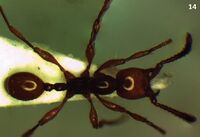Aenictus kodungallurensis
| Aenictus kodungallurensis | |
|---|---|

| |
| Scientific classification | |
| Kingdom: | Animalia |
| Phylum: | Arthropoda |
| Class: | Insecta |
| Order: | Hymenoptera |
| Family: | Formicidae |
| Subfamily: | Dorylinae |
| Genus: | Aenictus |
| Species group: | ceylonicus |
| Species: | A. kodungallurensis |
| Binomial name | |
| Aenictus kodungallurensis Antony & Prasad, 2022 | |
Aenictus kodungallurensis was collected from a coastal area with loose coastal alluvium soil by handpicking method.
Identification
Antony & Prasad (2022) - Aeniictus kodungallurensis is smaller in size than Aenictus malakkaparensis. The antennal scape of Aenictus malakkaparensis is shorter compared to Aenictus kodungallurensis. The shape of subpetiolar process is also different, the ventral margine between corners is straight or feebly concave in Aenictus kodungallurensis but it is convex in Aenictus malakkaparensis. Head and mesosome of Aenictus kodungallurensis is covered with dense hairs but in case of Aenictus malakkaparensis head and mesosome is only covered by sparse hairs.
Keys including this Species
Distribution
Distribution based on Regional Taxon Lists
Oriental Region: India (type locality).
Distribution based on AntMaps
Distribution based on AntWeb specimens
Check data from AntWeb
Countries Occupied
| Number of countries occupied by this species based on AntWiki Regional Taxon Lists. In general, fewer countries occupied indicates a narrower range, while more countries indicates a more widespread species. |

|
Estimated Abundance
| Relative abundance based on number of AntMaps records per species (this species within the purple bar). Fewer records (to the left) indicates a less abundant/encountered species while more records (to the right) indicates more abundant/encountered species. |

|
Biology
Castes
Nomenclature
The following information is derived from Barry Bolton's Online Catalogue of the Ants of the World.
- kodungallurensis. Aenictus kodungallurensis Antony & Prasad, 2022: 20783, figs. 9-16 (w.) INDIA (Kerala).
- Type-material: holotype worker.
- Type-locality: India: Kerala, Thrissur, Kodungallur, 10.238N, 76.161E, 9 m., 11.vi.2016 (A. Antony).
- Type-depository: ZSIK.
- Distribution: India.
Type Material
- Holotype: ZSI/WGRC/IR-INV.13902, 11.vi.2016, Female, worker, Kodungallur, Thrissur, Kerala, India, 10.238N, 76.161E, 9 m, hand collection on ground, coll. A. Antony.
Description
Worker
Holotype worker measurements: TL 2.40mm; HL 0.54mm; HW 0.50mm; SL 0.40mm; ML 0.89mm, PTL 0.20mm, PTH 0.17mm, PPTL 0.17mm, CI 89; SI 76.
Head: Head in full-face view sub rectangular, slightly longer than broad, sides convex, posterior margin almost straight; anterior part of head is broader than posterior part. Antennae with 10 segments, with ill-defined three segmented club and scape reaching almost 2/3 of head length. Anterior clypeal margin almost straight or feebly concave. Mandibles with basal margin edentate, masticatory margin of mandible with a large acute apical tooth followed by a medium-sized subapical tooth, two denticles, and a medium-sized basal tooth.
Mesosoma: Promesonotum convex dorsally and sloping gradually to metanotal groove; mesopleuron relatively long, clearly demarcated from metapleuron by a groove. Propodeum in profile with almost straight dorsal outline; propodeal junction angulate; declivity of propodeum fat, with blunt lateral carinae but not demarcated basally by a transverse carina. Petiole longer than high, node short, elevated posteriorly and dorsal outline convex; subpetiolar process low and subrectangular with anteroventral and posteroventral corners bluntly angulated and margin between the corners straight to feebly concave. Postpetiole clearly smaller than petiole, its dorsal outline convex.
Head, antenna and gaster entirely smooth and shiny; mandible finely striate. Promesonotum smooth and shiny except for anterior most portion punctate; mesopleuron with slightly irregular rugae; metapleuron, and propodeum wrinkled and reticulate. Petiole and postpetiole entirely reticulate except small area on dorsa smooth and shiny. Head and mesosoma dorsally with relatively dense standing hairs mixed with relatively dense decumbent hairs. Legs with dense long decumbent hairs. Mesosoma, petiole and postpetiole reddish-brown; head, antennal scape, gaster and legs yellowish-brown.
Etymology
The species name is after the type locality, Kodungallur.
References
- Antony, A.K., Prasad, G. 2022. Two new species of army ants of the Aenictus ceylonicus group (Hymenoptera: Formicidae) from Kerala, India. Journal of Threatened Taxa 14(3): 20780-20785 (doi:10.11609/jott.6962.14.3.20780-20785).
- Dhadwal, T., Bharti, H. 2023. Aenictus dirangensis sp. nov. (Hymenoptera: Formicidae), a new species of Aenictus ceylonicus group from India. Journal of the Entomological Research Society 25(2): 387-403 (doi:10.51963/jers.v25i2.2367).


